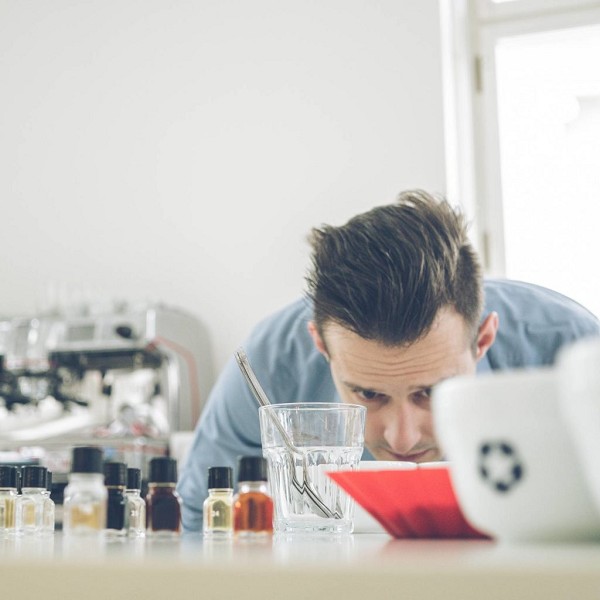A MATTER OF MECHANICS
Our mouth feels a range of perceptions connected to mechanics and movement.
The first sensation connected to the tactile sphere that we feel when drinking a coffee is the heat sensation, i.e., a heat normally felt due to the extraction temperatures, which are actually very high.
The same thing happens when we eat something too warm, thus, jeopardising the tactile analysis of the product. As a consequence, there is a risk of the tasting process becoming scuppered. It can be likened to when professional athletes get hurt and focus only on the physical pain they feel, tasters will also struggle, limiting their perceptions.
That’s why before starting a tasting session, professionals in the field “rinse” their mouth and immediately test a coffee’s tactile characteristics to be “mentally” prepared. “To rinse” is a verb that comes from the wine tasting field (preparing the glass for the tasting) and is a procedure that helps to prepare oneself for the following perceptions.
The receptors that allow us to have a tactile perception of the particles of a particular substance by defining its texture, size and shape, are present everywhere in the mouth, and on the tongue too, where the threadlike papillae responsible for tactile perception are to be found. On the tongue, there are some nerve endings connected to the trigeminal nerve allowing us to perceive also the chemical stimuli, which contribute to defining comprehensive descriptors, such as flavour. Therefore, at every bite, different phenomena will be triggered, varying the perception of every single sensorial characteristic.
It is easy to understand the weight of a coffee inside the mouth, thanks to comparisons concerning size, shape and texture, and elements that can unveil many details of the product we are tasting.
A spontaneous question is then: how much density should a coffee have to be pleasant to the taste, without resulting in a doughy and sticky feeling, which limits the perception of a high-quality flavour?
In the definition of the body of coffee, a range of tactile sensations is included. These come from different perception areas, such as the tongue, the palate and other parts of the mouth together with the kinaesthetic sensations connected to some physical stimuli and relatable with the mastication process and the deriving pressure.
It is important to remember that to assess the body of a coffee, the texture must be assessed too. This means assessing the density and also the consequent fineness.
As regards the mechanical features of the product, if we are assessing an espresso in the first stage of coffee tasting, we should pay attention to its viscosity, and, in some way, to the compactness of the cream. The thicker the cream is, the more the mastication is induced; and the more the sensation will be present, the more we will feel it between the tongue and the palate.
The lipidic content of an espresso is responsible for the creation of a glaze wrapping the palate, which slightly reminds us of the sensations felt after chewing a piece of chocolate.
Moreover, the position of the particles in a substance leads to a particular perception of it which undoubtedly changes due to the mastication process and the different temperatures inside the mouth.
Density and tactile quality are not always present together. This is because a coffee with a weak body can have homogeneous solid parts, therefore having substantial quality, although it doesn’t transmit a full-body sensation as most Italian blends do.
A good method to assess the quality and freshness of a coffee is to focus on its melt-in-the-mouth feature and its softness. An old coffee, in fact, has limited lipidic content, resulting in a less strong texture and in a reduced roundness sensation, typical of a freshly roasted coffee.
However, to understand how tactile perception has a developing scheme, it is possible to compare two alike products which have, however, a different texture and a different density.
The best way to identify this difference is to use solid products. In this example, we talk about two different kinds of honey.
These are the stages to follow:
- Choose two honey samples of the same category (expert advice: liquid linden or crystallised linden honey).
- Use a different teaspoon for each jar to spread the honey on the sides and perceive the common nuances.
- Identify the trigeminal sensations (temperature – pungency – freshness) and the kinaesthetic ones (viscosity – adhesiveness – hardness) for the two types of honey, remembering to clean the mouth after every taste with a piece of apple.
- Identify the major features,
It is noteworthy, however, that even though they have the same fragrance, the two products are different concerning tactile perception: for the liquid honey, the heat sensation is higher than in the crystallised one. The latter is, however, more consistent and with more granular and rubbery particles.
Except for particular processing methods, these typical tactile elements are a very good instrument to work and focus on the sensations, which can be possibly found in other products.
If we identify the astringency of dark chocolate, it will be easier to recognise the same sensation in a coffee, since it will limit its body and mouthfeel.
And if we also consider bitterness, besides astringency, it will be a little more complicated. But we will discover it… at the next sip!
Article from: https://bartalks.net/a-matter-of-mechanics










